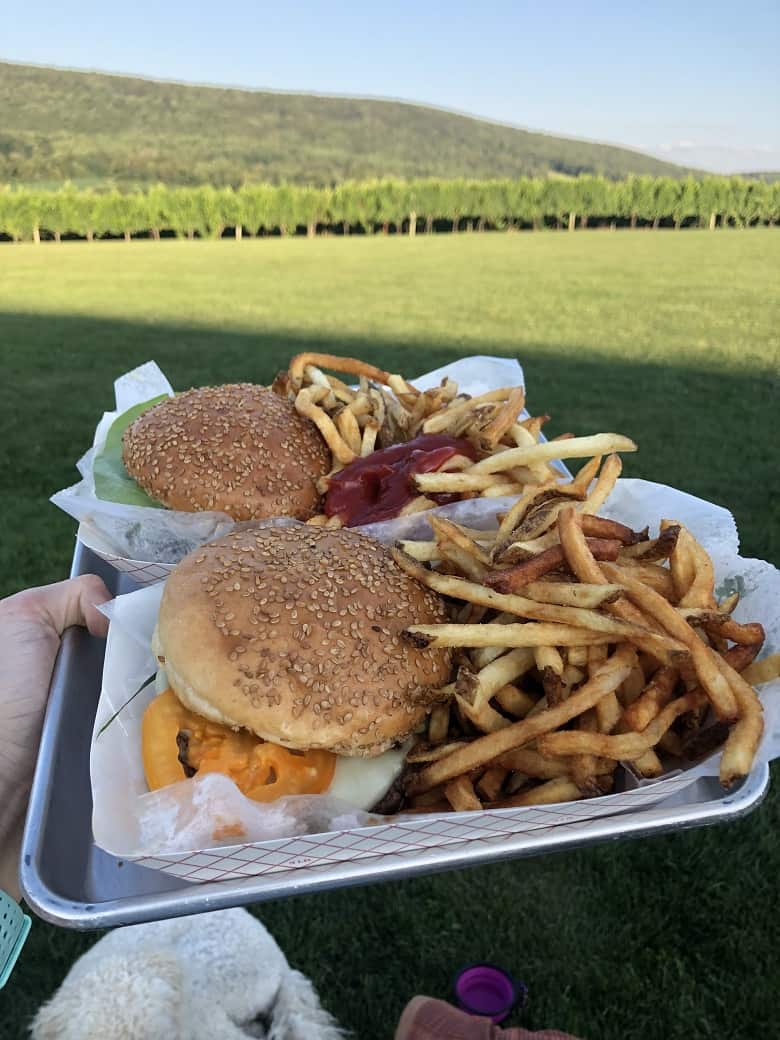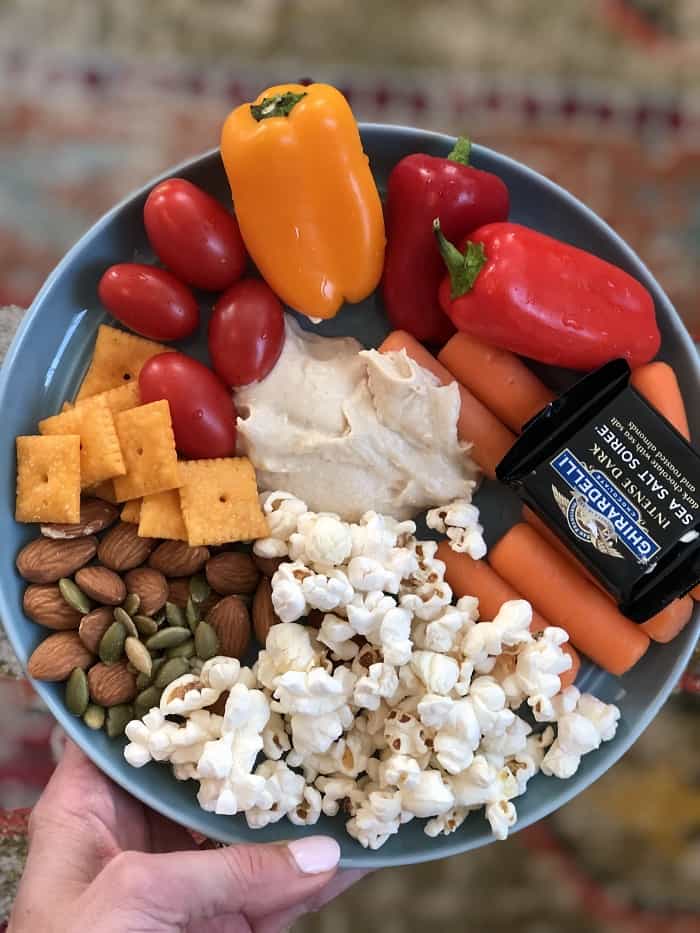Before understanding how to put the 10 principles of intuitive eating into practice, it’s essential to understand what intuitive eating is and isn’t, and how this framework can transform your relationship with food.

We live in a dynamic culture that is constantly feeding us new and re-used diet trends that promote strict regimens, cutting out entire food groups, never-ending food rules, and black and white/all-or-nothing thinking.
Adapting to these diet trends and listening to these external messages inhibit us from being in tune with our bodies and listening to what our bodies truly need.
Intuitive eating is an alternative to dieting, and a mind-body approach that supports treating your body with respect and kindness, while gently incorporating evidence-based nutrition that is practical for your lifestyle and fits your individual needs. It was developed by two dietitians, Evelyn Tribole and Elyse Resch.
In this blog post, we will break down each of the 10 principles of intuitive eating in an easy-to-understand-way, and provide you with the foundations of each principle.
Hopefully, after reading this post, you will have a better understanding about tuning into your internal cues and making peace with food.
I assume that since you’re here reading this post, you are familiar with intuitive eating and what it is. But if not, you should always start by reading the intuitive eating book or workbook!

Principle 1: Reject the diet mentality
Before we can start tuning in to our internal signals, we need to start with rejecting the external rules that diet culture has dictated for us.
Diet culture tends to take nutrition information and blow it out of proportion. It teaches us that foods are either “good or bad” and gives moral value to what we are eating.
Rejecting the diet mentality doesn’t mean rejecting all medical or performance-related nutrition advice. It means rejecting the idea that restriction and deprivation are “healthy” and signal “good willpower,” and the thought that weight loss needs to be achieved in order to be healthy.
It means rejecting the idea that being healthy looks a certain way.
In order to begin to reject the diet mentality, it’s important to recognize the damage that dieting has caused us. I encourage you to take a moment and think about what damage has dieting caused you?
- Has it brought more stress into your life?
- Has it taken up a boatload of time and effort that you could be putting somewhere else?
- Is your fear of certain foods dictated by what diets have told you is “good or bad?”
Consider where these messages show up for you – is it social media? Is it something that you were taught from a young age? Are you comparing yourself to someone or something that isn’t realistic for you?

Once you have identified the root of this diet mentality, start to challenge it! Use evidence-based nutrition knowledge and fight back against what diet culture messages tell you.
For example, if you know carbohydrates are our bodies main energy source, but diet culture has ingrained in you the carbs are “bad, ” try to reframe your thoughts.
Think of adding those extra carbs to your plate as extra energy to get through your day or workout. The performance plates help visualize some of these differences in energy needs.
Rejecting the diet mentality is the first step of the ten principles of intuitive eating to getting back in tune with your body’s cues.
It’s also a principle that aligns with my core and something we practice daily in our house with intuitive eating for kids. We tune in to OURSELVES, not anyone else.
Principle 2: Honor Your Hunger
It makes sense that after years of listening to external diet culture messages that tell us how much we should be eating and when to eat it that we have lost touch with our internal hunger cues. Honoring your hunger cues may not be on your radar right now.
Think about a time when you were on a diet – did you ever notice intense cravings for the exact items that your diet was telling you to get rid of? This is normal!
This is our body’s natural reaction to restriction. When we restrict our body, it ramps up our hunger hormones hoping that we’ll feed it.

Yet, rather than instinctively listen to these hunger signals, our first thought is why can’t I stick to this diet? Why am I feeling like this? We blame ourselves rather than the constructs of the diet itself.
It results in us feeling like we are failing the diet when really the diet is failing us. Hunger is a signal that lets our body know that it needs more fuel.
In our diet culture world, frequent hunger is usually seen as bad or a feeling of being out of control, but in reality, this signal is relaying information about our body’s needs in that moment.
Here’s something you can practice. The next time you sit down for a meal or snack, take a moment to kindly check in with yourself. Are you hungry? On a scale of 1-10, how hungry are you?
You can use this intuitive eating hunger scale to help you decipher.
What does this hunger feel like?
Hunger can look different for everyone. For some individuals, hunger will show up as a growling stomach and for others, it may be lack of concentration, headaches, or low energy.
We all experience hunger cues in different ways. Learning to honor your hunger is a process, and may take time to reconnect with internal hunger cues. Start by taking a step back and getting curious about what your body might be trying to tell you.

Principle 3: Make Peace with Food
It can be scary to try and include foods into your diet that have been restricted and off-limits for so long. Diet culture tells us that some foods are “good” or “bad,” which brings about guilt and shame when eating certain foods.
Yet, research shows that when we deprive ourselves of something that we want, it can actually heighten our desire for that item.
The intuitive eating 10 principles all seem to focus on making food less stressful and enjoyable because for so long, many of us have seen it otherwise.
Think about a pendulum or a weighted scale. On one end of the pendulum we have deprivation, and on the other, we have overeating. When we deprive ourselves of food we take the pendulum and bring it over to one side.
When we finally cave in and decide to indulge in our restricted food (picture the pendulum forcefully moving to the other side), our body becomes overly excited and we overindulge in that food, which then likely brings on feelings of guilt, and the restriction cycle starts again.

Making peace with food is a process, but if we remove foods from that pedestal, we can regain trust with that food item.
You can practice regaining this trust with food by making a list of foods that you consider “off-limits” or “bad”. Start by choosing one item that you circled, and give yourself permission to start eating this food.
Remember, it is a normal feeling to eat more of this food when you first introduce it. In fact, you may overeat it, and eat more than you planned.
This is your body’s response to having been deprived of this food for so long. Over time, this “pendulum” will balance out.

When you eat this food, check in with yourself. Ask yourself questions:
- Do you actually enjoy this food?
- Is it as good as you remember it?
- Does it still taste as good after a few bites?
Also, check back in with your hunger and fullness cues when eating it. Then keep this food around in the house so that you don’t re-trigger the deprivation mindset.
Remember to treat yourself with kindness and compassion. Some of these out-of-control feelings you may be experiencing around food is a natural response, and that it is only temporary!
Principle 4: Challenge the Food Police
The food police are the voices in our heads that monitor the unreasonable rules that diet culture has taught us. These messages from your internal food police may have originated from social media, ads you saw for a new diet product, or something that you have been told from a young age.
The food police usually bring about guilt or shame about foods that we find pleasurable and enjoy. Here are some more tips about how to deal with food guilt.
Think of a time when you were in the process of ordering something at a restaurant. You are sitting there staring at dozens of items on the menu when you hear a voice in your head say, “ I shouldn’t get a burger because it’s bad for me,” or “I’m really craving some fries, but I shouldn’t eat that many carbs.”

This is the food police in action. So, how do we stand up and challenge the food police?
We need to be observant and aware. Check in with yourself.
What are you thinking that’s actually causing you to feel this way? What kind of self talk are you using?
Think what is true and correct about this food belief or thought. Then, start to challenge these thoughts and reframe them.
For example if you are thinking “all foods high in fat are going to cause me to gain weight,” you can try reframing it to “adding higher fat foods helps make my food enjoyable and palatable.”
Generally, when the food police are talking, they can only think in black and white. Be kind to yourself and remember that food doesn’t have to be an all-or-nothing approach. Food flexibility is possible.
Principle 5: Feel your Fullness
We live in a world where tracking your every movement, workout, and food morsel has become the norm. Through diet apps such as my fitness pal, weight watchers, etc., diet culture has taught us that we need to adjust to eating less to “be healthier.”
It tells us that feeling hungry is “normal” and that feeling fullness is “bad”. This can make tackling this principle of feeling your fullness challenging, as it may not be something that you have experienced consistently, and it may feel uncomfortable to feel a physical sensation after eating.
Feeling your fullness is about tuning into your body and looking for signals telling you that you are done eating. In order to be able to consistently feel comfortable with knowing when to stop eating, we need to be able to give ourselves unconditional permission to eat foods.
If you are still restricting yourself in any manner, you will have thoughts that “you may not be able to have this food again,” and are likely to eat beyond fullness and have a “last supper mentality.” This means that you may eat to uncomfortable fullness to justify the last time you’ll eat these foods, and then start the restriction process again.

In order to overcome this diet culture norm and begin to feel a pleasant fullness again, it can be helpful to slow down, pause, and to check in with yourself before and during meals.
Remember, some physical fullness and distention is necessary. We want to eat enough so we don’t need to constantly think about food for the next few hours.
Ask yourself questions like:
- How is the food tasting right now?
- Why do I feel the urge to finish this?
- If you were to stop eating now, would you be missing out on anything?
- Would you still be thinking about food if you stop eating now?
- Is this still enjoyable?”
While slowing down to try to limit distractions, allow yourself to tune in during that moment and help bring awareness to how you’re feeling.
You may realize that once you give yourself unconditional permission to enjoy these foods any time of day, you’re able to stop eating at a comfortable point.
Principle 6: Satisfaction with Food
We can’t talk about fullness without discussing satisfaction when eating. If you’ve wondered how to feel satisfied after eating, this is a major principle to focus on.
Discovering the satisfaction factor ties into the previous principle of feeling your fullness. Satisfaction is about creating meals and snacks that you enjoy, and is known as the hub of intuitive eating.

Think about a time you may have been craving a food, but decided to indulge in a “healthier” option. In the moment, that one healthier option may not have been satisfying for you, and you find yourself seeing out 4 different “healthier” options, but still don’t feel satisfied.
So, you decide to indulge in that satisfying food anyway.
It is important to incorporate foods that are enjoyable and pleasurable to you, as part of the satisfaction principle. Adding more tastes, textures, or components to meals can help with finding satisfaction.
Take the example of having a plain salad with just a few vegetables and chicken. Eating this meal might not be very satisfying, but adding things like nuts, dried fruits, tortilla chips, or dressings can help to make this meal feel satisfied and balanced (here’s a great example of just that).
Adding a carbohydrate, protein, and fat source to each meal, like we discuss in building a balanced plate, is a good first step to trying to achieve the satisfaction factor.
Satisfaction encompasses:
- the environment you’re eating in (is it pleasurable?)
- your hunger level when you start the meal
- how quickly you eat the meal
- whether you enjoy the meal
- are you eating what you really want vs. what you think you should eat?
- are you satisfying an emotional craving?
- whether it’s foods you like and want
- anything happening in the background
- are you wearing comfortable clothes and eating without body bashing?
- whether you’re in the diet mentality when you’re eating that food (are you labeling foods as “good”/”bad”)

Principle 7: Cope with Emotions with Kindness
Emotional eating gets a bad reputation. We know that food IS emotional.
Diet culture tells us that we shouldn’t use food to cope with our emotions. But, eating is an emotional experience.
Imagine moving to a new city by yourself and feeling homesick. The perfect solution to make you feel better might be your mom’s homemade mac and cheese or maybe, it’s a box of kraft mac and cheese, bringing back the feeling of being the lucky sibling to stir in the cheese packet.
Traveling can often evoke forms of emotional eating to aid in the excitement of trying new foods. Here’s a post on intuitive eating when traveling.
Emotional eating is normal and can be soothing in some situations. The key to emotional eating is being intentional about your decision to soothe with food and realizing that you have other coping mechanisms if you need them.
Ask yourself if eating this food helps? If it is something that is giving you comfort, then great!
However, if you notice that it is making you feel worse or just numbing you out from feeling any emotion at all, this is when having additional coping mechanisms in your toolbox can be helpful.
Activities that you might add to your toolbox could be:
- calling a friend
- speaking with a therapist
- crying
- journaling
- showering or taking a bath
- exercising
- painting your nails or getting them done
- watching your favorite show
Don’t let diet culture tell you that you aren’t allowed to emotionally eat. Check in with yourself and find what activity suits you best in that moment of emotion.
Principle 8: Respect Your Body
Much of diet culture is rooted in the standards that society sets about how we should or shouldn’t look. This principle about learning to respect your body is so important and goes hand and hand with rejecting the diet mentality.
Reject that we have to look a certain way. All of us are genetically different and were meant to be that way.
Body respect is something that is different for everyone, so I challenge you to define that for yourself. What does body respect look like to you?

This could be investing in comfortable clothing, showing up for yourself, taking care of your body. We also don’t have to be in love with our bodies. We don’t have to wake up every single day and think, “oh my gosh, I am so in love with how I look.”
Setting realistic expectations is important. Can we like our body, or even just feel neutral about it for even the time being?
How to start
Start by expressing gratitude towards your body.
Write down things that your body does for you. Focus on what accomplishments your body has gotten you through.
What can you attribute to your body outside of aesthetics?
Then challenge the context. If you are thinking that you need to look a certain way, why? Where does this come from? Take a step back and look at the big picture.
If there was a day that you remember that you didn’t like your body, what happened that day? What was that like? Were you going through some difficult times and it felt easier to blame your body than to feel other emotions?
Remember that weight doesn’t equal health. Your body does so many amazing things every day, and we can try to shift our focus to celebrate all of the things that it provides us with.
Be patient – this takes time.
Principle 9 – Move to Feel the Difference
We are humans, we are meant to move. We generally feel better when we do. However, when we place pressure on that notion, or engage in movement we don’t enjoy, then are we really getting the health benefits? Likely not as much.
Exercise is often portrayed as a way to “burn calories” or “lose weight.” Both of these ideas place so much stress on movement that should be joyful.
This principle is about finding a way to move your body that feels good for you instead of using exercise as punishment for something that you ate or are about to eat.
When we are told we need to work out for x minutes a day or burn x amount of calories per workout, this can take an enjoyable exercise and make it miserable.

To find movement that you find joyful, it can be helpful to switch your mindset. It is also important that we try to identify what is motivating our workouts. Is it these external motivating factors like minutes worked out, pounds lost, calories burned, etc.?
Or is it something that we truly enjoy doing? Does the workout improve your energy levels, do you enjoy the activity that you are doing, does it help you deal with stress?
It is also common for individuals to feel the need to ignore their body cues and work out every single day. This is a form of compulsive exercise. It is often viewed as a negative thing to take a rest day.
However, this “push through” mentality is ruining exercise for us and taking away the enjoyment. We have to remember that movement should be joyful and make us feel good.
Movement should give us more energy – not take it away. Resting is crucial for muscle recovery and injury prevention as well. This post talks about what to expect for recovery after exercise.
Principle 10: Honor Your Health with Gentle Nutrition
This last principle of gentle nutrition ties evidence-based nutrition recommendations into these principles, but in a gentle way.
While research supports certain ways of eating for performance and health, it is important to take into account individual preferences, lifestyle, and the practicality of these nutritional recommendations and allow for flexibility.
We want to honor foods that taste good and also make you feel good.
There is a misconception that intuitive eating is all about just eating whatever you want, and while you do have permission to eat whatever foods your body is craving, we do need to be practical and dive into how these foods are going to make you feel.

If you are really craving a cheeseburger but know that you are going to be running in a few hours, it might be practical to wait until after your run to eat the cheeseburger, as eating it prior to your run may cause you to feel sluggish, or sick. We talk about this more in the athlete’s hunger scale.
Some ways to incorporate gentle nutrition into your lifestyle could be focusing on the big picture. Realize one meal isn’t going to completely ruin your health, yet it’s more about our overall eating pattern.
Allow yourself to enjoy foods that bring you joy. Focus on adding foods into your diet, not what foods you should be taking out. For example, how can you add more foods into your diet that bring you energy? Try and add a variety of different foods to supply your body with different nutrients.
Pay attention to what feels good to you. Notice what foods are comforting, energizing and connecting. Try not to let diet culture tell you what is best for your body and listen to what your body is trying to tell you.
These principles lay a great foundation for reconnecting with your body and tuning out the harmful diet culture messages. They will take time and practice to implement, and working with an intuitive eating dietitian is always a good idea.
If you are starting on your journey to intuitive eating, I recommend starting with a step that feels most applicable and manageable to you, to re-explore your connection with your body.
For more resources on intuitive eating, check out these posts:

